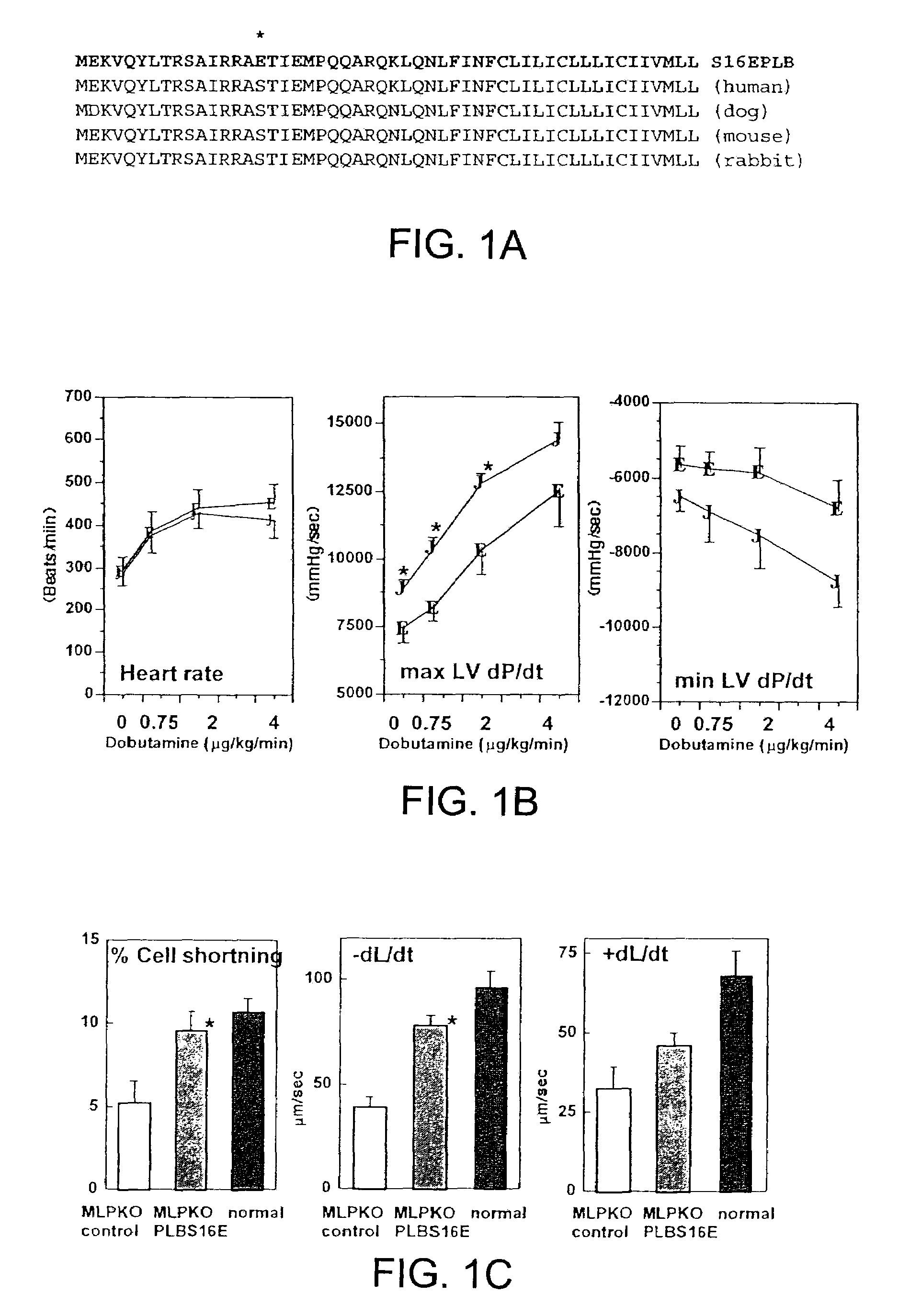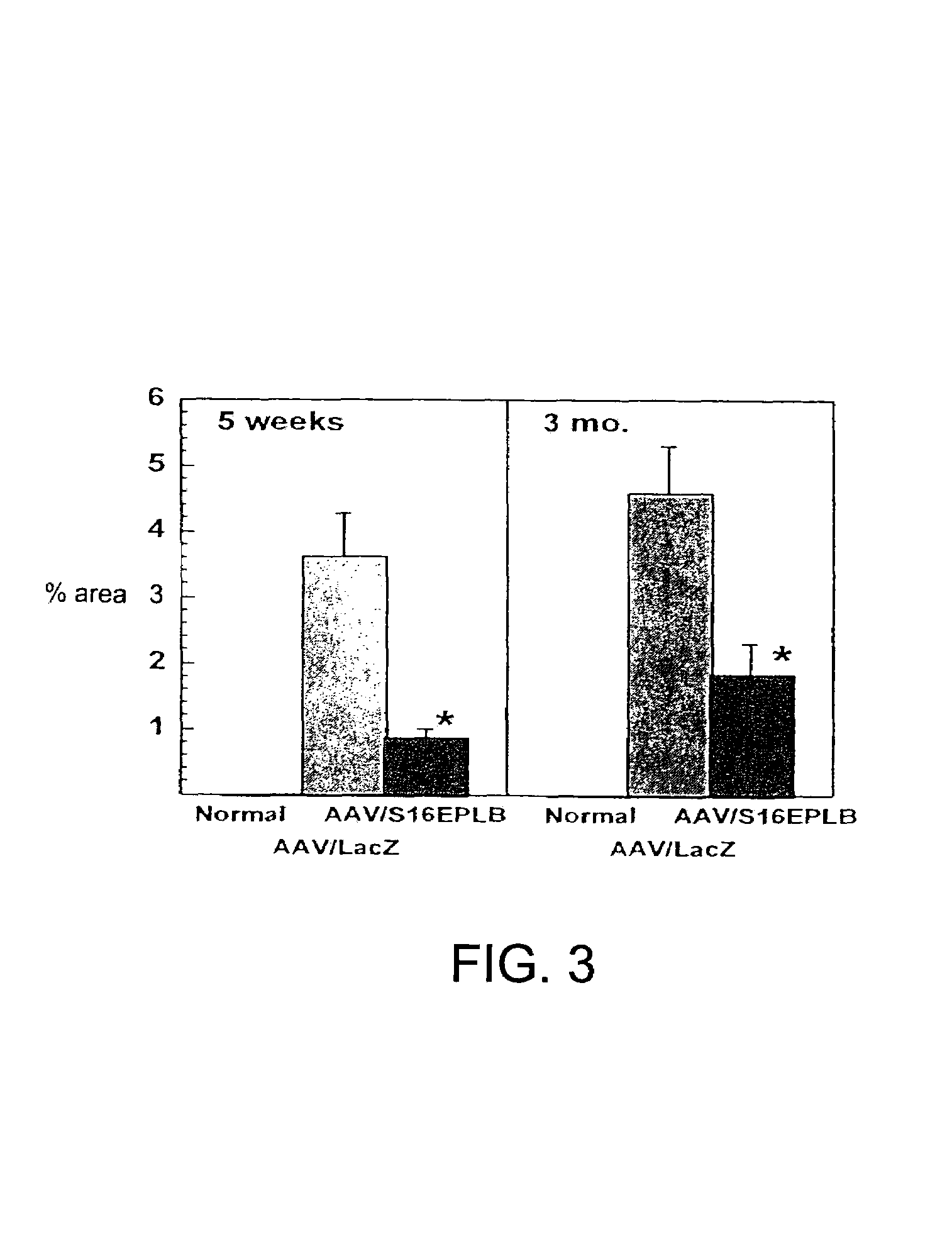Methods for cardiac gene transfer
a gene transfer and gene technology, applied in the direction of dsdna viruses, peptide/protein ingredients, drug compositions, etc., can solve the problems of affecting the practical application of gene transfer in vivo, affecting the effect of cardiac gene transfer, and uneven gene expression, etc., to achieve high level of in vivo cardiotopic gene transfer, high consistency, and efficient gene transfer and expression
- Summary
- Abstract
- Description
- Claims
- Application Information
AI Technical Summary
Benefits of technology
Problems solved by technology
Method used
Image
Examples
example 1
[0030]Construction of viral vectors. A replication deficient (E1A and E1B deleted) Ad vector was constructed that contains the β-galactosidase gene with a nuclear localization signal sequence (Ad.CMV LacZ) or the hamster δ-sarcoglycan gene (Ad.CMV δ-sarcoglycan) driven by the CMV promoter. The viral constructs were generated by the use of the shuttle vector PACCMV.PLPA by the method of Graham et al., 1995 (incorporated herein by reference). Ad vectors generated by in vitro recombination were amplified in 293 cells. Cells were harvested and subjected to three freeze-thaw cycles to release the virus particles. Virus was purified through two consecutive CsCl gradients. The average titers of the viruses were 1.27×1011 pfu / ml for AdV.CMV LacZ and 5.5×109 pfu / ml for Ad.CMV δ-sarcoglycan.
[0031]AAV vectors are based on the non-pathogenic and defective parvovirus type 2 and were constructed essentially as described by Xiao, et al. 1998 (incorporated herein by reference). Briefly, the three p...
example 2
[0032]In vivo transduction. Hamsters were anesthetized with sodium pentobarbitol (85 mg / kg, i.p.), intubated and ventilated, ECG electrodes were placed on the limbs and a 6F thermistor catheter was inserted into the rectum. The chest was shaved and a small (4-5 mm) left anterior thoracotomy performed in the second intercostal space; braided silk ligature were looped around the ascending aorta and the main pulmonary artery and threaded through plastic occluder tubes. Through a midline neck incision, the right carotid was exposed, cannulated with flame-stretched PE-60 tubing and the tip advanced into the ascending aorta just above the aortic valve (below the aortic snare) for measurement of arterial pressure and later injections of viral particles.
[0033]Bags filled with ice water were placed around the supine animal, including the head, and the heart rate and temperature were monitored every three minutes until the core temperature reached 18° C. (average time 40 minutes in the normal...
example 3
[0035]Transduction procedure using a reporter gene does not alter cardiac function. Normal hamsters (n=10) were studied by echocardiography (ECG) at 4 days post Ad.CMV LacZ administration. The percent fractional shortening (% FS) of the left ventricle was 43.88±5.45%, indicative of normal function and the left ventricle end-diastolic dimension (LVDd) was 4.38±0.22 mm, indicative of normal heart size. In a group of age-matched normal, untreated hamsters, the % FS was 46.83±2.43 and the LVDd was 4.12±0.3 mm (not significantly different). In the CM hamsters, some animals were examined by echocardiography both pre- and 6 days post-administration of Ad.CMV LacZ. The left ventricular function was depressed in control CM hamsters vs. wild-type hamsters as expected (% FS 27.77±3.17%, LVDd 5.44±0.25 mm) and somewhat further depressed 6 days later (% FS 23.59±4.93%, LVDd 5.60±0.37 mm, both p<0.05).
PUM
| Property | Measurement | Unit |
|---|---|---|
| temperature | aaaaa | aaaaa |
| temperature | aaaaa | aaaaa |
| pressure | aaaaa | aaaaa |
Abstract
Description
Claims
Application Information
 Login to View More
Login to View More - R&D
- Intellectual Property
- Life Sciences
- Materials
- Tech Scout
- Unparalleled Data Quality
- Higher Quality Content
- 60% Fewer Hallucinations
Browse by: Latest US Patents, China's latest patents, Technical Efficacy Thesaurus, Application Domain, Technology Topic, Popular Technical Reports.
© 2025 PatSnap. All rights reserved.Legal|Privacy policy|Modern Slavery Act Transparency Statement|Sitemap|About US| Contact US: help@patsnap.com



